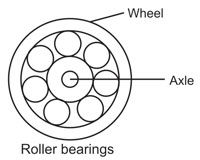|
Ways of Reducing Friction in Machines
Just as friction has
advantages, which are the uses it can be put into,
see uses of
friction, it also has disadvantages. It causes wear of machine parts,
and it uses up energy and therefore reduces the efficiency of machines. Here are
different ways friction can be reduced in machines.
Reducing Friction by Applying Oil
A common way of reducing
friction is to lubricate the surfaces of machines, which slid over each other
with oil. With a layer of oil between the machine surfaces, friction is reduced
as the parts slid over each other.
Oils lubricate better when hot
because they are less viscous as they become hot. This explains why engines
usually don’t start easily in cold weather when the oil is cold, but the
engine becomes more efficient as it warms up.
However, if an engine overheats
and the oil gets too hot, it can get denatured as a result of the chemical
decomposition of its structure that could occur.
Reducing Friction by Using Ball
or Roller
Bearings
Ball or roller bearings is used
to reduce friction where a wheel is turning on an axle. Ball or roller bearings
are like wheels, which roll round the axle as the wheel turns.

They wear out much slowly, as
they apply static friction, rather than trying to overcome kinetic friction.
See
coefficient of kinetic friction here
See
kinetic friction here
See static friction here
See
coefficient of static friction here
See
friction here
See
calculating friction here
|